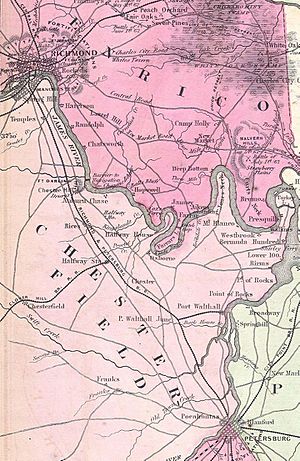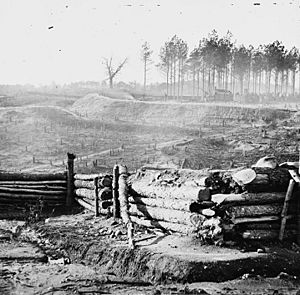Bermuda Hundred campaign facts for kids
The Bermuda Hundred campaign was a series of battles during the American Civil War. It happened in May 1864 near the town of Bermuda Hundred, outside Richmond, Virginia. Union General Benjamin Butler led his army to attack Richmond from the east. But Confederate General P. G. T. Beauregard stopped him.
Contents
Planning the Attack on Richmond

In March 1864, Ulysses S. Grant became the top commander of all Union armies. He planned a big attack on the Confederacy from many directions. Grant wanted to hit the Confederacy hard in several places at once.
One part of this plan involved Grant and George Meade attacking Robert E. Lee's main army. Another part was for General Butler to move his army by boat. Butler's goal was to sail up the James River to the Virginia Peninsula. From there, he would march northwest towards Richmond.
Butler's Mission and Army
Butler's main job was not to capture Richmond directly. Instead, he needed to cut the Richmond and Petersburg Railroad. This railroad was a very important supply line for the South. If Butler could cut it, Lee would have to send soldiers to protect it. This would make Lee's army weaker against Grant and Meade.
General Butler was chosen partly because he supported President Abraham Lincoln. He was not known for winning many battles. To help him, Grant gave Butler two strong generals: Quincy Adams Gillmore and William Farrar Smith.
Location of Bermuda Hundred
The campaign is named after the fishing village of Bermuda Hundred. This village is on a piece of land between the Appomattox River and the James River. It is southeast of Richmond and northeast of Petersburg. Union warships could not go past Drewry's Bluff, which was further up the James River.
On May 5, Butler's army landed at Bermuda Hundred. This was the same day Grant and Lee started fighting in the Battle of the Wilderness. Butler also sent some troops to City Point, which could threaten Petersburg.
General P. G. T. Beauregard led the Confederate forces against Butler. He had about 18,000 soldiers. Many of these were young teenagers or older men. Beauregard's troops around Petersburg were led by George Pickett.
Key Battles of the Campaign
The Bermuda Hundred campaign included several important battles.
Port Walthall Junction (May 6–7, 1864)
On May 6, Confederate General Johnson Hagood's soldiers stopped the first Union attacks. This happened at Port Walthall Junction, which was important for controlling the railroad. The next day, a Union division pushed Hagood's troops back. They cut the railroad line. The Confederates then moved back behind Swift Run Creek.
Later, Confederate soldiers melted down the railroad tracks. They used the metal to make cannons.
Swift Creek (May 9)
General Butler tried to move towards Petersburg. He met Confederate General Bushrod Johnson's division at Swift Creek. A Confederate attack at Arrowfield Church failed and they lost many soldiers. But the Union forces did not follow up their advantage.
Butler seemed happy just to destroy railroad tracks. He did not push the Confederates further. At the same time, five Union gunboats went up the Appomattox River. They tried to attack Fort Clifton. Union Colored Troops also tried to attack by land. But the gunboats were quickly driven away. The land attack was also stopped.
Chester Station (May 10)
Confederate soldiers led by General Robert Ransom checked on Butler's army. Butler's troops were destroying the railroad at Chester Station. The Confederates attacked near the Winfree House. The Union soldiers then went back to their defenses at Bermuda Hundred.
Proctor's Creek (May 12–16)
Butler moved north to attack the Confederate line at Drewry's Bluff. But he became defensive when his attack was not supported by gunboats. On May 13, a Union group attacked the right side of the Confederate line. They took over some defenses.
However, Butler remained careful. This gave Beauregard time to bring more of his soldiers together. On May 16, Ransom's Confederate division attacked Butler's right side. Many Union units ran away. Other attacks got lost in the fog. The Union soldiers became disorganized and lost hope. After hard fighting, Butler pulled his army back. He returned to his Bermuda Hundred defenses. This battle effectively ended Butler's attack on Richmond.
Ware Bottom Church (May 20)
Confederate forces under Beauregard attacked Butler's line. This happened near Ware Bottom Church. About 10,000 soldiers fought in this battle. The Confederates pushed back Butler's forward guards. Then, they built a strong defense line called the Howlett Line. This line trapped the Union forces at Bermuda Hundred.
After the Campaign
General Butler's mission was not successful. He was "bottled up" at Bermuda Hundred and could not move. He did manage to keep some Confederate forces busy for a short time. But the Confederate wins at Proctor's Creek and Ware Bottom Church were important. These victories allowed Beauregard to send many soldiers to help Lee's army. These extra troops arrived in time for the fighting at Cold Harbor.
General Grant wrote about Butler's situation in his book, Personal Memoirs. He talked to his Chief Engineer about it:
He said that the general occupied a place between the James and Appomattox rivers which was of great strength... but that he could do nothing offensively. I then asked him why Butler could not move out from his lines and push across the Richmond and Petersburg Railroad... He replied that it was impracticable, because the enemy had substantially the same line across the neck of land that General Butler had. He then sketched the locality, remarking that the position was like a bottle and that Butler's line of intrenchments across the neck represented the cork; that the enemy had built an equally strong line immediately in front of him across the neck; and it was therefore as if Butler was in a bottle. He was perfectly safe against an attack; but... the enemy had corked the bottle and with a small force could hold the cork in its place.
– Ulysses S. Grant, 'Personal Memoirs'
Grant's engineer said that Butler's position was like a bottle. Butler was safe inside, but the Confederates had "corked" the bottle. This meant Butler could not get out to attack.
Butler's soldiers were later used in the Siege of Petersburg. Federal troops stayed at Bermuda Hundred throughout that siege.
See also
 In Spanish: Campaña de Bermuda Hundred para niños
In Spanish: Campaña de Bermuda Hundred para niños


